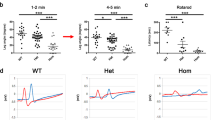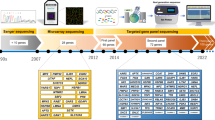Abstract
Charcot–Marie–Tooth disease type 1B (CMT1B) is genetically linked to chromosome 1q21–23. The major peripheral myelin protein gene, P0, has been cloned and localized to the same chromosomal region. P0 is a 28 kDa glycoprotein involved in the compaction of the multilamellar myelin sheet and accounts for more than half of the peripheral myelin protein content. We checked whether P0 is altered in CMT1B, and show here that a 3 basepair deletion in exon 2 of the P0 gene is present in all affected individuals of a CMT1B family. The mutation results in the deletion of serine 34 in the extracellular domain of P0, suggesting that alterations of P0 cause CMT1B.
This is a preview of subscription content, access via your institution
Access options
Subscribe to this journal
Receive 12 print issues and online access
$209.00 per year
only $17.42 per issue
Buy this article
- Purchase on Springer Link
- Instant access to full article PDF
Prices may be subject to local taxes which are calculated during checkout
Similar content being viewed by others
References
Hoogendijk, J.E. & De Visser, M. Hereditary neuropathies and spinocerebellar atrophies. in Handbook of Clinical Neurology Vol 60 (eds Vinken, P.J. et al.) (Elsevier, Amsterdam, 1991).
Harding, A.E. & Thomas, P.K. The clinical features of hereditary motor and sensory neuropathy types I and II. Brain 103, 259–280 (1980).
Vance, J.M. et al. Linkage of Charcot-Marie-Tooth neuropathy type 1a to chromosome 17. Exp. Neurology 104, 186–189 (1989).
Vance, J.M. et al. Localization of Charcot-Marie-Tooth disease type 1a (CMT1a) to chromosome 17p11.2. Genomics 9, 623–628 (1991).
Hoogendijk, J.E. et al. The duplication in Charcot-Marie-Tooth disease type 1a spans at least 1100 kb on chromosome 17p11.2. Hum. Genet. 88, 215–218 (1991).
Raeymaekers, P. et al. Duplication in chromosome 17p11.2 in Charcot-Marie-Tooth disease type 1a (CMT1a). Neuromusc. Disord. 1, 93–97 (1991).
Raeymaeckers, P. et al. Estimation of the size of the chromosome 17p11.2 duplication in Charcot-Marie-Tooth neuropathy type 1a (CMT1a). J. med. Genet. 29, 5–11 (1992).
Lupski, J.R. et al. Gene dosage is a mechanism for Charcot-Marie-Tooth Disease type 1A. Nature Genet. 1, 29–33 (1992).
Lupski, J.R. et al. DNA duplication associated with Charcot-Marie-Tooth Disease type 1a. Cell 66, 219–232 (1991).
Bird, T.D., Ott, J. & Giblett, E.R. Evidence for linkage of Charcot-Marie-Tooth disease to the Duffy locus on chromosome 1. Am. J. hum. Genet. 34, 388–394 (1982).
Lebo, R.V. et al. Chromosome 1 Charcot-Marie-Tooth disease (CMT1B) locus in the Fc-γ receptor gene region. Hum. Genet. 88, 1–12 (1991).
Defesche, J.C., Hoogendijk, J.E., De Visser, M., Ongerboer de Visser, B.W. & Bolhuis, P.A. Genetic linkage of hereditary motor and sensory neuropathy type I (Charcot-Marie-Tooth disease) to markers of chromosome 1 and 17. Neurology 40, 1450–1453 (1990).
Griffiths, L.R., Zwi, M.B. & McLeod, J.G. Chromosome 1 linkage studies in Charcot-Marie-Tooth 1. Am. J. hum. Genet. 42, 756–771 (1988).
Suter, U. et al. Trembler mouse carries a point mutation in a myelin gene. Nature 356, 241–244 (1992).
Suter, U. et al. A leucine-to-proline mutation in the first transmembrane domain of the 22-kDa periferal myeline protein in the trembler-J mouse. Proc. natn. Acad. Sci. U.S.A. 89, 4382–4386 (1992).
Patel, P.I. et al. The gene for the peripheral myelin protein PMP-22 is a candidate for Charcot-Marie-Tooth disease type 1A. Nature Genet. 1, 159–165 (1992).
Valentijn, L.J. et al. The peripheral myeline gene PMP-22/GAS-3 is duplicated in Charcot-Marie-Tooth disease type 1a. Nature Genet. 1, 166–170 (1992).
Timmerman, V. et al. The peripheral myelin protein gene PMP-22 is contained within the Charcot-Marie-Tooth disease type 1A duplication. Nature Genet. 1, 171–175 (1992).
Matsunami, N. et al. Peripheral myelin protein-22 gene maps in the duplication in chromosome 17p11.2 associated with Charcot-Marie-Tooth 1A. Nature Genet. 1, 176–179 (1992).
Valentijn, L.J. et al. Identical point mutations of PMP-22 in Trembler-J mouse and Charcot-Marie-Tooth disease type 1a. Nature Genet. 2, 288–291 (1992).
Kuhn, K., Pravtcheva, D., Ruddle, F. & Lemke, G. The gene enconing peripheral myelin protein zero is located on mouse chromosome 1. J. Neurosci. 10, 205–209 (1990).
Oakey, R.J., Watson, M.L. & Seldin, M.F. Construction of a physical map on mouse and human chromosome 1, comparison of 13 Mb of mouse and 11 Mb of human DNA. Hum. molec. Genet. 1, 613–620 (1992).
Lemke, G. & Axel, R. Isolation and sequence of a cDNA encoding the major structural protein of peripheral myelin. Cell 40, 501–508 (1985).
D'Urso, D. et al. Protein zero of peripheral nerve myelin, biosynthesis, membrane insertion, and evidence for homophylic interaction. Neuron 4, 449–460 (1990).
You, K.H., Hsieh, C.H.L., Hayes, C., Stahl, N., Francke, U. & Popko, B. DNA sequence, genomic organization and chromosomal localization of the mouse peripheral myelin protein zero gene, Identification of polymorphic alleles. Genomics 9, 751–757 (1991).
Hayasaka, K. et al. Isolation and sequence determination of cDNA encoding the major structural protein of human peripheral myelin. Biochem. Biophys. Res. Commun. 180, 515–518 (1991).
Filbin, M.T., Walsh, F.S., Trapp, B.D., Pizzey, J.A. & Tennekoon, G.I., Role of myelin P0 protein as a homophilic adhesion molecule. Nature 344, 871–872 (1990).
Lemke, G., Lamar, E. & Patterson, J. Isolation and analysis of the gene encoding peripheral myelin protein zero. Neuron 1, 73–83 (1988).
Amzel, L.M. & Poljak, R.J. Three dimensional structure of immunoglobulins. Ann. Rev. Biochem. 48, 961–997 (1979).
Suzuki, M. et al. Phosphorylation of P0 glycoprotein in peripheral nerve myelin. J. Neurochem. 55, 1966–71 (1990).
Giese, K.P., Martini, R., Lemke, G., Soriano, P. & Schachner, M. Mouse P0 gene disruption leads to hypomyelination, abnormal expression of recognition molecules and degeneration of myelin and axons. Cell 71, 565–576 (1992).
Sambrook, J., Fritsch, E.F. & Maniatis, T. Molecular cloning. A laboratory manual 2nd edn (Cold Spring Harbor Laboratory Press, New York, 1989).
Orita, M., Suzuki, Y., Sekiya, T. & Hayashi, K. Rapid and sensitive detection of point mutations and DNA polymorphisms using the polymerase chain reaction. Genomics 5, 874–879 (1989).
Dracopoli, N.C., O'Connel, P. & Elsner, T.I. The CEPH Consortium linkage map of human chromosome 1. Genomics 9, 686–700 (1991).
Rogne, S., Mykleborst, O. & Hoyheim, B. The genes for Apolipoprotein All (APO-A2) and the Duffy Blood group (Fy) are linked on chromosome 1 in man. Genomics 4, 169–173 (1989).
Weber, L.J., Kwitek, A.E. & May, P.E. Dinucleotide repeat polymorphism at the CRP locus. Nucl. Acids Res. 15, 4635 (1992).
Floyd-Smith, G., Whitehead, A.S. & Colton, H.R. The human C-reactive protein gene (CRP) and serum amyloid, a component gene (APCS) are located on the proximal long arm of chromosome 1. Immunogenetics 24, 171–176 (1986).
Raeymakers, P., van Broeckhoven, C. & Backhovens, H. The Duffy bloodgroup is linked to the α-spectrine locus in a large pedigree with autosomal dominant inheritance of CMT1. Hum. Genet. 78, 76–78 (1988).
Swallow, D.M., Trounstine, M.L. & Vaux, D.J.T. The hypervariable locus pUM, which codes for tumour associated epithelial mucins, is located on chromosome 1, within region 1q21-24. Ann. hum. Genet. 51, 289–294 (1987).
Grundy, H.O., Peltz, G. & Moorek, W. The polymorphic FcγRII gene maps to human chromosome 1q. Immunogenetics 29, 331–339 (1989).
Warmerdam, P.A.M., van de Winkel, J.G.J., Gosselin, E.J. & Capel, P.J.A. Molecular basis for a polymorphism of the human Fcγ receptor II (CD32). J. exp. Med. 172, 19–25 (1990).
Author information
Authors and Affiliations
Rights and permissions
About this article
Cite this article
Kulkens, T., Bolhuis, P., Wolterman, R. et al. Deletion of the serine 34 codon from the major peripheral myelin protein P0 gene in Charcot–Marie–Tooth disease type 1B. Nat Genet 5, 35–39 (1993). https://doi.org/10.1038/ng0993-35
Received:
Accepted:
Issue Date:
DOI: https://doi.org/10.1038/ng0993-35
This article is cited by
-
Mechanisms and Treatments in Demyelinating CMT
Neurotherapeutics (2021)
-
Two novel missense mutations in the myelin protein zero gene causes Charcot-Marie-Tooth type 2 and Déjérine-Sottas syndrome
BMC Research Notes (2010)
-
U1 snRNA mis-binding: a new cause of CMT1B
neurogenetics (2010)



